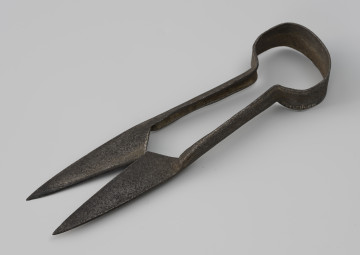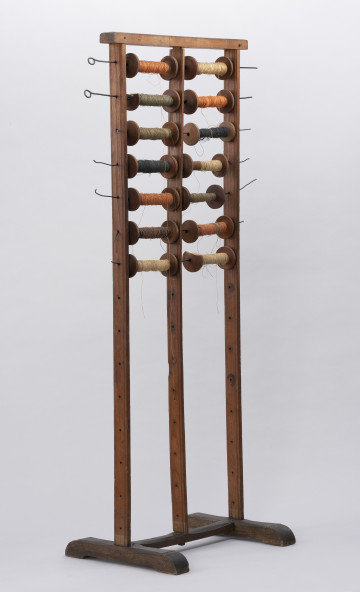
Sheep shearers
1851 — 1939
National Museum in Szczecin
Part of the collection: Folk weaving
Wool, extracted from the hair of animals, often sheep, is a good textile thanks to its thermal insulation and hygroscopic properties and has been used by people for centuries. In order for it to be used as a textile raw material, it needs to be processed properly. After shearing, which was traditionally done with special spring-loaded bail shears, the wool was very often washed. Sometimes, however, this was dispensed with or the sheep was washed even before shearing. The washed wool was dried and then combed. The latter was done simply with the fingers – hence the old name runo(fleece) meaning a thing ripped, with the use of special combs or, in time, with the help of grisaille brushes. The ethnographer, Kazimierz Moszyński, describes grisaille brushes as "a kind of even comb with numerous iron hooks hammered into the skin". The grisailles were rectangular in shape and had simple handles. While working, wool was applied to one of the brushes and combed with the other. Because they were larger and denser than combs, working on them was more efficient. The combed wool was spun and then dyed using natural dyes and, from the first half of the 19th century, factory dyes as well. The brush shown here has a typical rectangular shape. It originated in Western Pomerania in the second half of the 19th century and was donated to the museum in the 1970s by a private individual. Agnieszka Słowińska
Author / creator
Object type
carding brush
Technique
carpentry techniques
Material
wood, leather, metal
Origin / acquisition method
donation
Creation time / dating
Creation / finding place
Owner
Muzeum Narodowe w Szczecinie
Identification number
Location / status

1851 — 1939
National Museum in Szczecin

1880 — 1920
National Museum in Szczecin

1801 — 1939
National Museum in Szczecin
DISCOVER this TOPIC
Museum of King Jan III's Palace at Wilanów
DISCOVER this PATH
Educational path